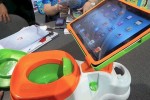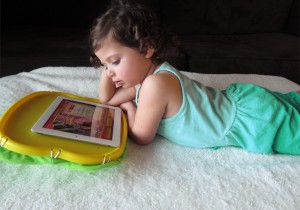
The special needs community is greatly benefiting from the iPad – and it was never even created to be a therapeutic device.
It’s hard to believe that apps have only been around for four years. They were first introduced on the iPhone in July 2008. The iPad debuted in January 2010. In this short time, the iPad and touch devices have revolutionized the technology industry. The iPad has emerged as a preeminent tool for business professionals, parents, schools, educators, kids, and most notably, the special needs community. While the iPad was not created for the sole purpose of being a disabilities aid or therapeutic device, it has built-in accessibility features and other key features that provide immense value to people with disabilities – especially children.
As technology has evolved, especially with the iPad and the variety of apps, we have begun utilizing it more heavily in our practice to help children maximize their level of participation, interaction and function within their activities of daily living (also known as ADLs),” says Amy B. VanCamp, Pediatric OT at Carolina Pediatric Therapy (Asheville, NC).
5 key features make the iPad most beneficial to helping children with disabilities:
1. Accessibility Features
The iPad (and other Apple devices) comes with accessibility features – built-in modifications that make it easier for users with visual, auditory or other physical disabilities to use iPad. This includes VoiceOver, Zoom, White on Black, Mono Audio, and Speak Auto-Text.
Many children have limited ability to interact with toys for typical developing children and therefore their play and readiness skills for school are limited. The accessibility features that come standard on all Apple products meet many needs for our clients.” (VanCamp)
2. Special Education Apps
The App Store has apps designed for people with disabilities that further support its accessibility features, such as the SoundingBoard,(create customs boards for communication) Proloquo2Go (touch-to-speak), SoundAmpR (auditory amplification), and more.
These apps and others are highlighted on the Apple Store’s own Special Education section featuring apps for Communication, Emotional Development, Seeing & Hearing, Language Development, Literacy & Learning, Organization, and Diagnostics & Reference.
3. Over 20,000 Education Apps for iPad
Apple recently announced at their Education Event that 20,000 education apps have been built for the iPad. They highlight their education apps with links to the App Store on their website. This variety gives educators, parents and children a chance to explore and utilize a vast range of content. For more information and downloads, explore the educational apps section of the App Store.
4. Portability
The iPad is completely portable. While desktop computers and laptops posed obvious challenges for those with limited mobility, the iPad can be easily positioned to accommodate a variety of positions – seated, supine, prone and lying down. Many companies are also creating accessories for iPad to help mount and position the iPad in various ways to make it more accessible to people with physical disabilities.
5. Motivation
It is well known that iPad touch technology supports interactive features that include drag and drop, tap, swipe, shake and drawing. These features add an element of fun to activities, making many apps such as Monkey Preschool Lunchbox and Richard Scarry’s Busytown (to name a couple) a cross-over between “educational” and “games.” This creates motivational incentive for children to engage who might otherwise be less motivated.
According to Van Camp, this has proven especially true with children with autism and writing apps (i.e. Pre-K Letters and Numbers, Little Writer, and Doodle Buddy). She explains that in the past many therapists found it challenging to teach writing to children with autism due to a child’s lack of motivation or interest.
Writing apps have given therapists another way of teaching writing in a multi-sensory / technology approach.” (VanCamp)
What Results Can Be Seen?
There are an estimated 2.8 million children in the U.S. with a disability (U.S. Census 2010). Many children with disabilities are making great strides through app therapy with the iPad. VanCamp reports she has seen clear, measurable results in her clients, including increased motivation, participation, communication, and improvement in fine motor and visual motor skills. Read more about VanCamp’s work using the iPad to help children with special needs here.
Apple supports the needs of the Special Education community by integrating the accessibility features into all of their devices – outlined on the Apple website. They dedicate a section on their website to Special Needs.
The CVAA – Landmark Law
Apple as an outlier may have even inspired landmark legislation for people with disabilities. The Twenty-First Century Communications and Video Accessibility Act (CVAA) was signed into law by President Barack Obama on October 8, 2010. The legislation, authored by Representative Edward J. Markey, Mass-D, requires mobile devices to be more accessible to users with disabilities. Approximately three-fourths of communications and video devices are required to make adaptations for blind and deaf people. The CVAA also ensures that accessibility laws enacted in the 1980s and 1990s are brought up to date with 21st century technologies, including digital, broadband, and mobile. More about the law is outlined on the FCC website here.
The Future of Apps for the Special Education community
Can the iPad replace real life experiences? Obviously not. But can it enhance real life experiences by helping maximize activities of daily living? Clearly, it can. Together, developers, Apple, educators, and our government are helping pave the way for more breakthroughs in technology to come. For the special needs community and children born today with disabilities, the future seems especially bright.
Read more about How iPad Therapy is Changing Lives of Children with Disabilities.
Please SHARE this post and spread the word about the benefits of app therapy for children with special needs.






